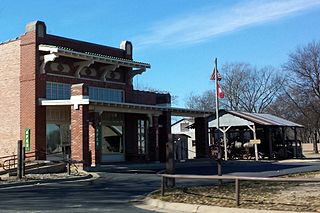
Scott is an unincorporated community and census-designated place (CDP) in Lonoke and Pulaski counties in the central part of the U.S. state of Arkansas. Per the 2020 census, the population was 97. It is part of the Little Rock–North Little Rock–Conway Metropolitan Statistical Area.
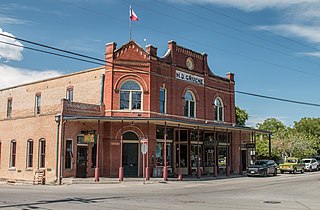
Gruene is a German-Texan town in Comal County in the U.S. state of Texas. Once a significant cotton-producing community along the Guadalupe River, the town has now shifted its economy to one supported primarily by tourism. Gruene, a German surname, is now a district within the city limits of New Braunfels, and much of it was listed in the National Register of Historic Places on April 21, 1975. The city is known for its German-Texan heritage and architecture and many residents of Gruene and New Braunfels are descendants of the first German settlers.

The Kemp Cotton Gin Historic District encompasses the only cotton gin extant in the Rohwer area of Desha County, Arkansas. The gin was built in 1950 by O. O. Kemp, a few years after the closure of the Rohwer War Relocation Center, where as many as 10,000 Japanese-Americans were interned during the Second World War. After the center's closure much of its land was returned to agricultural use, and Kemp built this gin near the Missouri Pacific Railroad line that ran through Rohwer. In addition to the gin, the complex Kemp built includes a pump house, scale house, and office. This entire complex was listed on the National Register of Historic Places in 2005.
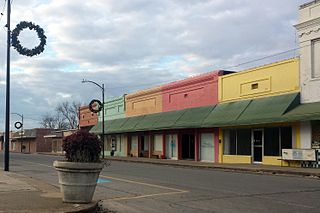
The Lake Village Commercial Historic District encompasses the historic commercial heart of Lake Village, Arkansas, the county seat of Chicot County in the Mississippi River delta region of southeastern Arkansas. The district covers about six square blocks of downtown Lake Village, bounded roughly by Jackson Street to the north, Lakeshore Drive to the east, Church Street to the south, and Chicot Street to the west. This area represents the growth of Lake Village during its period of greatest prosperity, between 1906 and 1960. The city's growth was spurred by the arrival of the railroad in 1903, and most of the district's buildings were built between 1900 and 1930. Most of the buildings are vernacular commercial buildings; the John Tushek Building at 202 Main Street is one interesting example of Beaux Arts styling, and 218–222 Main Street has some Italianate styling. The district includes the Lake Village Confederate Monument, which has been a local landmark since 1910.

The Cotton Belt Railroad Depot is a historic railroad station at the junction of Main and 1st Streets in downtown Fordyce, Arkansas. The single-story brick building was built c. 1925 by the St. Louis Southwestern Railway, also commonly known as the Cotton Belt Railroad. The building is predominantly Craftsman in its styling, with extended eaves that have elaborately styled brackets.

The Fordyce Commercial Historic District encompasses the historic heart of Fordyce, Arkansas, the county seat of Dallas County. It encompasses four city blocks of North Main Street, between 1st and 4th, and includes properties on these adjacent streets. Fordyce was founded in 1882, and the oldest building in the district, the Nutt-Trussell Building at 202 North Main Street, was built c. 1884. Spurred by the logging industry and the Cotton Belt Railroad, Fordyce's downtown area had 25 buildings by 1901, and continued to grow over the next few decades, resulting in a concentration of period commercial architecture in its downtown. The district was listed on the National Register of Historic Places in 2008.
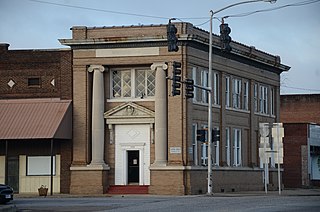
The Prescott Commercial Historic District encompasses the historic commercial core of Prescott, Arkansas, the county seat of Nevada County. Prescott was laid out in 1873, after the railroad was built through the area that is now Nevada County, and the railroad has played a significant role in the city's development. The railroad today bisects the commercial core of the city, which extends for several city blocks away from the railroad. The historic district includes all of the major civic buildings of the city, including the courthouse, post office, and the old Prescott City Jail.

The Cotton Belt Railroad Office Building is a historic commercial building at 312 East Broad Street in Texarkana, Arkansas. Built c. 1910, this two-story brick building is one of the oldest buildings in downtown Texarkana. Its exterior walls have been stuccoed, and it has a flat roof behind a stuccoed brick parapet. It has vernacular Italianate styling, with two-story pilasters separating the front bays, and dentil molding at the roof line. The main facade is divided into three bays, the central one providing the main entry on the first floor, and an arched-top window above. The flanking bays are plate glass on the first floor, with tripled sash windows above. The building's first tenant was the Cotton Belt Railroad, whose arrival was responsible for Texarkana's significant growth in the early 20th century.

The John H. Johnston Cotton Gin Historic District encompasses a historic cotton gin in the small community of Levesque, Arkansas. The main building of the gin was built in 1941, and was built out of reinforced concrete, instead of the more usual steel, owing to a metal shortage in World War II. It has some Moderne styling, with smooth surfaces and rounded corners. The gin also distinctively incorporates a seed storage facility at its rear. Its ancillary structures, which include a shed, privy, and cyclone structure, are wood-framed with metal siding and roofing.

The Wynne Wholesale Commercial Historic District encompasses a small collection of historic commercial properties in Wynne, Arkansas. It extends for two blocks along West Merriman Avenue, west of Martin Luther King Jr. Boulevard, and includes four historic buildings: the Wynne Municipal Water Works, the Wynne Wholesale Grocer Company building, the R. J. Jackson Gin Company's cotton gin, and the Sharp Floral Building. A fifth building, the Wynne Ice & Coal Company's ice house, also stands in the district, but has been recently modified. These building are representative of wholesale business activities that took place in Wynne in the first half of the 20th century.

The Lepanto Commercial Historic District encompasses the traditional commercial heart of the small city of Lepanto, Arkansas. The district includes one block of Greenwood Avenue between Berry and Holmes Streets, and portions of two more blocks at either end, as well as two blocks of Berry Street, with a few buildings on adjacent streets. Lepanto was founded in 1903, but its surviving commercial architecture only dates as far back as c. 1915, when the Portis Company cotton gin was built at the eastern end of the district. Other early buildings include the triangular c. 1920 Arlington Light and Power building at 320 Greenwood, and the unusual Barton's of Lepanto building at 111 Berny Street, built as a wood frame lumber yard office c. 1920; its walls were bricked in 1955 when it was converted to a hardware store.
The Piggott Commercial Historic District encompasses the original center of the city of Piggott, Arkansas, as originally platted out in 1887. It is centered on the square where the Clay County courthouse is located, buildings facing the courthouse square, and also buildings along some of the adjacent streets. In addition to the courthouse, the district includes the c. 1910 railroad depot, city hall, two churches, the 1930s Post Office building, a cotton gin, and a grain storage yard. The town grew because of the railroad, and the plentiful timber in the area, whose harvesting fueled the early economy in the region. The oldest building in the district is the 1897 Clay County Bank at 188 West Main Street.

The Walnut Ridge Commercial Historic District encompasses the historic town center of Walnut Ridge, Arkansas, the county seat of Lawrence County. The district includes a four-block stretch of Main Street on the northwest side of the railroad tracks, and extends for one and sometimes two blocks on either side. Walnut Ridge was founded as a railroad town in 1875, and soon became a leading economic center in the county. Most of its historic downtown consists of vernacular commercial architecture dating to the late 19th and early 20th centuries, built of masonry and brick, and one or two stories in height. Notable buildings include the 1924 Swan Theatre at 222 West Main Street, the 1935 Old Walnut Ridge Post Office at 225 West Main, and the 1965 Lawrence County Courthouse at 315 West Main, which replaced a c. 1900 structure.

The Cotton Plant Commercial Historic District encompasses the historic civic and commercial center of the city of Cotton Plant, Arkansas. It includes about two blocks of Main Street, between Elm and Ash on the south side, and between Pine and just short of Vine on the north side. The district includes 19 historically significant buildings dating, most of which were built between about 1900 and 1930. The town grew as a railroad shipping center for cotton beginning in the 1880s, but major fires in 1901 and 1924 devastated parts of its downtown, resulting in a large number of early 20th-century commercial brick buildings.
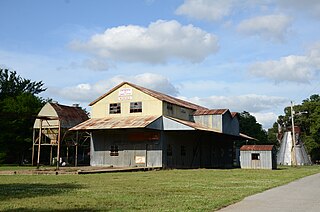
The Weldon Gin Company Historic District encompasses a historic cotton gin complex in Weldon, Arkansas. With a history dating to 1833, the Weldon Gin Company was long a staple of the local economy. Located in the center of the town at the junction of Weldon and Washington Streets, the company complex includes a main gin building, built in 1939, and four outbuildings. The present mill was built to replace an earlier steam-powered mill after electricity was introduced to the area in the 1930s.

The Hanger Cotton Gin is a historic cotton gin in Sweet Home, Arkansas. Built about 1876, it is a rare surviving example of a steam-powered gin. The main building is a three-story frame structure covered in board-and-batten siding. The gin was only operated commercially for a brief period, and was out of service by 1892. Since then, the building has been used as a barn and grain storage facility. It was probably built by Peter Hanger, whose family has been prominent in the Little Rock business community since that time.

The Stipe Cotton Gin is a historic cotton gin at Florida and Cypress Streets in Beebe, Arkansas. It is a two-story steel-framed structure, clad in corrugated metal, that houses the steam compressor and other equipment for processing and baling cotton. The complex also includes a seed storage building, and a circular structure of uncertain function. Built about 1930, it is one of only five to survive in White County from that period, when cotton production was locally at its peak.

The Waterbury Village Historic District encompasses most of the central commercial and residential area of Waterbury, Vermont. Located along United States Route 2 and Stowe Street south of Thatcher Branch of the Winooski River, the sprawling village has been shaped by changes in transportation in the 19th and 20th centuries, and by key economic developments such as the founding of the Vermont State Hospital, which anchors the village's southern end. The district was listed on the National Register of Historic Places in 1978.

The Burton Farmers Gin is a 2- and 3-story cotton gin house located close to the commercial district of Burton, Texas. It has also been known as Burton Farmers Gin Association's Site No. 3. It was listed on the National Register of Historic Places in 1991. It hosts the Texas Cotton Gin Museum. Besides the gin, the museum includes cotton warehouses and a shoe shop.
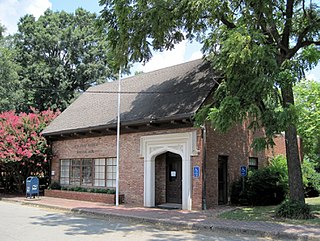
The Willson Commercial Historic District encompasses the commercial and industrial heart of Wilson, Arkansas. Founded in 1886 as a company town by Robert Edward Lee Wilson, the city's growth was regulated and planned by the company until it was formally incorporated in 1950. This district encompasses the historic town square, commercial buildings, and the administrative and industrial buildings of the company's cotton gin and flour mill.





















